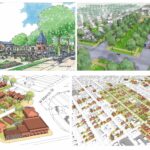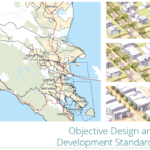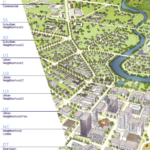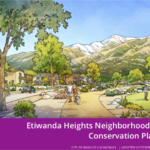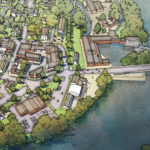New FBC a Big Win for Winooski
Winooski, a small city in northwestern Vermont that sits at the mouth of the Winooski River, tends to be overshadowed by its far larger and more populous neighbors, Burlington, South Burlington and Colchester. However, the positive effects of the form-based code (FBC) Winooski began implementing in 2015, is helping it to become one of the Burlington metropolitan area’s most vibrant and accessible cities and, as a result, an increasingly popular residential market.
Unlike most Vermont cities, which have a mix of urban and rural communities, Winooski is entirely urban and densely populated, with about 7,200 people occupying just 1.52 square miles.
The decision to develop an FBC for Winooski was driven in 2012 by then-city manager Katherine “Deac”Decarreau’s and the Winooski Planning Commission’s desire to breathe new life into many of the city’s developed but underused areas. They also sought to make the city more attractive, pedestrian-friendly and responsive to the needs and interests of current and future businesses, residents and visitors.
The city and the Chittenden Regional Planning Commission decided to focus its efforts on redeveloping the three major transportation “gateway” corridors that connect Winooski to Burlington and other parts of the Champlain Valley which covers areas surrounding Lake Champlain in Vermont and New York and extends north slightly into Quebec.
The commission, in close consultation with the community at large, decided to pursue an FBC as the development regulation tool for the gateway districts and, through a request for proposals process, selected the consultant team of Ferrell-Madden, Dreher Design Associates, Inc. and Urban Advantage to develop the code. The project partly was funded through grants from the Federal Highway Administration with Winooski providing a 20 percent local funding match.
The team explored the existing layout of the city and held a week-long public participation charrette in order to involve the residents in the planning of their futures, which included both long-time residents and recent immigrants who sought to start small businesses along the corridors, to arrive at proposals for the gateway corridors’ form and function. The team then developed the code based on their vision and used an additional community vetting process to obtain public buy-in for it.
“The community came together in support of multi-use development, taller buildings, positioning storefronts on tree-shaded sidewalks rather than behind parking lots to improve the corridors’ appearance and an expedited permitting process,” said Paul Dreher, founder of Dreher Design Associates, who was on the consulting team and now, as the city’s acting zoning administrator, is responsible for implementing it.
He recalled the challenges involved in meeting the city’s potentially competing objectives.
“We had to balance the need to accommodate heavy traffic along the gateway corridors with the city’s desire to increase pedestrian activity alongside them, which called for broad sidewalks and buildings close to the streets. This entailed talks with city engineers on how to accommodate these two priorities.” We were impressed with city decision makers’ responses and cooperation. They clearly understood what we were going for,” he explained.
He said he was impressed by how well the new FBC reflected and addressed Winooski’s density challenges, in part by consulting closely with residents and business owners to understand their concerns and aspirations. He attributed this in no small part to the experience Ferrell-Madden brought to seeking community participation and ensuring the public’s feedback was incorporated in the FBC.
“For example, Winooski has a large and ethnically diverse number of recent immigrants who, Deac Decarreau told us, gave the city its competitive edge. Ferrell-Madden made a point of making translators available during discussions to capture their perspectives, which stressed the need to develop businesses near these major transportation corridors but, in many cases at a small parcel level. Some of these residents aspired to renovate or open a space to operate a small market with, say just 75 square feet of frontage. The city needed a code that would let a business owner know that he or she could participate at a major or more incremental level of development. The resulting code is designed to accommodate businesses of various sizes” he explained.
One challenge the city still faces is the traditional zoning requirement that every building provide at least more parking spaces — than the team believes are needed, which challenges the FBC’s intent, to make the affected areas more pedestrian friendly
by making it possible, and even inviting, to “park once” and reach multiple establishments on foot. This is a debate that Dreher, who recently became Winooski’s acting zoning administrator, is prepared to take on.
“I have been meeting with the planning commission to present evidence that the parking standards we have proposed have reduced the need for parking spaces and developers are concurring, saying they don’t need that much parking and that it adds to project costs and to the rents property owners have to charge,” said Dreher.
Despite this obstacle, he noted that Winooski’s new FBC is encouraging the development of affordable housing with energy efficient standards built in. And, although the permitting process has been streamlined, development is proceeding at an incremental pace and incorporates restraints to ensure that it is scaled to the size and nature of the surrounding neighborhoods.
“The city is clearly committed to following the code and ensuring that the FBC’s spirit and intended effects are reflected in the way the city’s public spaces are shaped and function,” Dreher said
Meanwhile, although many people in Burlington would like to adopt an FBC, substantial resistance from traditional land-use zoning proponents stands in the way.
The population throughout the Champlain Valley is rising rapidly as is the cost of real estate — rental rates rival those charged in New York City, Dreher a South Burlington resident, reported.
“You could build 100 units in these cities tomorrow and they’ll fill up but an increasing number of local residents are saying they’re thinking about buying in Winooski. That’s due in no small part because the city adopted a code that is in keeping with its small-town, inviting, user-friendly character,” he said. “A lot of the credit for that goes Geoffrey Ferrell and Mary Madden, principals of Ferrell-Madden.Their vast experience in writing FBCs and leading the efforts to elicit and incorporate local feedback into the FBC make it truly reflective of this community. After the code passed, I called Geoff and told him that years from now, the kids who are born in Winooski will be thanking you for the FBC we’re putting into place.”





